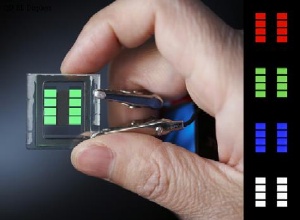Nanoco Technologies is producing a full colour range of displays using their proprietary quantum dots which includes their cadmium free quantum dot technology (CFQDTM).

Nanoco is unique in the nanomaterials market as a company that manufacture large quantities of quantum dots and partner major R&D and blue-chip industrial organisations in the development of quantum dot applications.
Quantum dots (QDs) are nano-scale crystals comprising various elements. The properties and performance of these unique crystals is determined by the size and composition of the QD. Nanoco Technologies has developed the ability to ‘engineer’ these properties in a unique manner, allowing adjustments to the performance and properties of the QD in a rapid and cost effective manner.
QDs are both photo active (photoluminescent) and electro active (electroluminescent) and because of their unique physical characteristics they can be readily incorporated into OLED displays.
QDs are a new form of light emitting technology and incorporating them into displays brings many added benefits including:
- Better colour purity : the colour produced by QDs is considerably better than competing OLED technologies resulting in improved viewing experience for the end user;
- Added flexibility : QDs are soluble in both aqueous and non-aqueous solvents, which provides for printable and flexible displays of all sizes, including large area TVs (QDTV™);
- Improved lifetime : QDs are inorganic; as such they offer the potential for improved lifetimes when compared to alternative OLED technologies.
Dr Nigel Pickett, CTO of Nanoco Technologies, commented: “We are very excited to be producing this range of QD Technocolour displays. With high colour purity red, green, blue and white, our QD materials mean manufacturers can make a whole range of displays from mobile devices through to large area TVs”.
Nanoco’s CFQDTM Technocolour displays are also a green technology. The environmental benefits from using CFQDTM materials range from decreased power consumption in the display devices, decreased power consumption in the manufacturing process and an improved lifetime of the devices themselves. The cadmium free materials also mean manufacturers can comply with environmental RoHS legislation (RoHS 2002/95/EC).
Prototypes of these displays will be showcased at the nano tech 2009 event in Tokyo which takes place from 18 – 20 February.